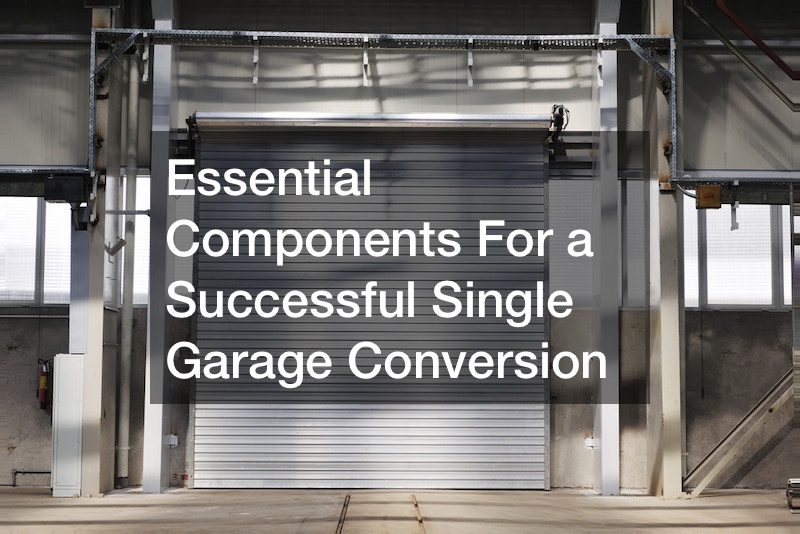Conversions are a common renovation project undertaken by homeowners who want to maximize the potential of their property. In recent years, converting a single garage into a usable living space has become increasingly popular. You can convert your single garage to suit your needs better and add value to your home, all while maintaining the structural integrity of the overall property.
A single garage conversion can be a cost-effective way to increase the living space in your home. However, planning and considering all necessary components is important before beginning this project. Here are some essential components for a successful single garage conversion.

1. Planning and Design
Planning and design are the cornerstones of any successful garage conversion project. It involves assessing the potential of your existing space, identifying your requirements, and creating a design that unifies the two. The planning phase includes considering how the conversion will integrate with the rest of your house, deciding on the layout, and determining the location of doors, windows, and other features.
The design phase, on the other hand, involves the detailed specifications of the conversion. It should address the aesthetic, functional, and structural aspects to ensure the converted space is appealing and useful. The design should ideally include features that complement your home’s existing architecture. A good example is matching the roofline and exterior finish to ensure a seamless blend.
If you plan on converting your single garage into a local carport, consider consulting with local building suppliers for materials and guidance. This will help you comprehensively understand what is feasible within your budget and space constraints. They can also provide insights on the best materials to use for your specific project.
Planning and designing your single garage conversion is crucial for a successful project. Taking the time to carefully plan and consider all aspects will save you time, money, and stress in the long run. Consult with professionals and utilize your resources, such as local building suppliers, for a smooth and successful conversion process.
2. Building Regulations and Permissions
Before you begin your single garage conversion, you must familiarize yourself with your locality’s building regulations and permissions. These regulations ensure people’s safety, health, and welfare in and around buildings. They encompass rules regarding the structural integrity, fire safety, energy efficiency, and accessibility of the conversion.
For example, your roofing company may need to verify that your roof can support any additional weight from the conversion, or alterations may need to be made to ensure it meets the local codes for snow or wind load. The converted garage may also need to meet specific energy efficiency standards to prevent heat loss.
Permissions, on the other hand, refer to the formal consent required before starting construction or alterations. Depending upon where you live, you may need planning permission or a permit to convert your garage. This could depend on factors such as the building’s historical status, its visual impact on the neighborhood, or whether the conversion changes its use.
A single garage conversion often falls under ‘permitted development, ‘ meaning it doesn’t require planning permission. However, this isn’t always the case, especially if you live in a conservation area or your house is a listed building. It’s essential to check with your local planning department to determine what’s required for your specific project.
Failure to comply with building regulations or to obtain necessary permissions can lead to legal repercussions, including fines or being required to undo the work. Therefore, it’s crucial to understand and comply with these regulations and permissions to ensure the legal and safe execution of your garage conversion. Always consult with knowledgeable professionals, such as architects, structural engineers, or a trusted roofing company, to guide you through this process.
While a garage conversion can be an excellent way to add living space and value to your home, it’s essential to consider all the necessary permissions and regulations before starting. Doing so can ensure a successful conversion that meets all safety standards and complies with local laws. This can help you avoid any legal disputes or issues in the future related to your garage conversion. Furthermore, following the proper procedures can also help you save time and money by avoiding potential delays or fines.

3. Structural Considerations
When planning a single garage conversion, it’s imperative to understand the structural implications. The existing structure’s design and integrity significantly influence the conversion process and its success. One of the first considerations is the garage’s foundation. If you’re working with a precast concrete company, ensure they thoroughly inspect to determine if the current foundation can withstand the conversion changes.
Another primary consideration is the garage’s walls and roof. They may need to be reinforced or rebuilt by hiring a local restoration service, mainly if the conversion includes adding another level or heavy features such as a large aquarium or chimney. It’s also worth considering the interior structural components, such as load-bearing walls, which should remain undisturbed unless necessary to avoid impacting the overall structural integrity of the building.
Lastly, consider the conversion’s impact on your property’s drainage system. Converting a garage could alter the drainage and surface water flow, which may require modifications to your existing system to prevent potential issues in the long run.
4. Insulation and Temperature Control
Proper insulation and temperature control are crucial when converting a garage into a habitable space. Choosing the right insulation material, such as spray foam, can greatly enhance the new space’s comfort, energy efficiency, and overall livability. It can also reduce energy bills and improve your property’s resale value.
A spray foam insulation company can offer superior thermal performance and can effectively reduce heat transfer. This material expands on application, filling cracks and gaps and forming an air-tight barrier. It can help maintain a consistent indoor temperature, reducing the need for constant heating or cooling and lowering energy bills.
HVAC contractors should also be engaged to ensure your garage conversion has adequate temperature control. The existing HVAC system in your home may not be equipped to handle the additional load of the converted garage. A professional can assess whether your current system needs upgrades or if a separate system is more suitable for the new space.
Consult with professionals in spray foam insulation and HVAC services early in the planning stage. These steps are about comfort and creating an energy-efficient and environmentally responsible space. Proper insulation and temperature control strategies will also contribute to your converted garage’s durability and long-term value.
5. Electrical and Plumbing Work
When transforming a single garage into a functional living area, it’s essential to consider the electrical and plumbing requirements. These two components are critical to the conversion’s success and functionality. Both of these are crucial in ensuring the comfort and convenience of your new space.
Starting with the electrical work, your garage conversion may require additional outlets, light fixtures, and possibly even dedicated circuits, depending on its intended use. Hiring a licensed electrician is recommended, as they can ensure the wiring is done correctly, safely, and in compliance with local codes. This work may extend to installing a new breaker in your electrical panel to handle the additional load. Remember that any electrical work needs to be well-planned to provide adequate power for all the appliances and devices you intend to use in the space.
On the plumbing side, if your garage conversion includes a bathroom, kitchenette, or laundry area, having a professional plumber involved is essential. Key considerations include the location of existing water and waste lines, the need for a new water heater, and whether your current water pressure is sufficient. Sometimes, you may need to install a water pump to ensure adequate water supply. A good plumber will ensure all fixtures and appliances are installed correctly and comply with local building regulations.
Though electrical and plumbing work may seem daunting, with careful planning and the help of professionals, these tasks can be managed efficiently, ensuring your garage conversion is safe, functional, and compliant with all necessary regulations. It can be expensive and time-consuming, but getting these crucial elements right from the start is vital. In addition to hiring professionals, make sure to obtain all necessary permits and inspections to avoid any potential issues down the line.

6. Flooring and Walls
After the electrical and plumbing work has been completed, the next step in a single garage conversion is to address the flooring and walls. This typically involves insulating, installing a subfloor, and finishing the floors and walls. These are crucial steps to ensure your converted garage is comfortable and maintains a consistent temperature.
Insulation is crucial for creating a comfortable living environment in your converted garage. The walls and the floor should be insulated to keep the space warm in winter and cool in summer. The insulation will also provide soundproofing, enhancing the privacy and usability of the space. Flooring options for a garage conversion are diverse and can be selected based on your preference and the room’s intended use. Some popular choices include carpet, hardwood, laminate, or tile. Consider durability, maintenance, comfort, and style when choosing your flooring.
The walls of your garage conversion should typically be finished with drywall. Drywall repairs might be needed if any existing damage or new electrical or plumbing components have been installed. Ensure the drywall is installed correctly and painted to give your space a clean, finished look. Remember that the process of converting a single garage into a livable space involves many steps and a variety of trades and skills. Hiring professionals for drywall repairs ensures that the work is done correctly and can prevent future issues.
7. Lighting and Ventilation
Proper lighting and ventilation are core aspects of a successful single garage conversion. They are responsible not only for the comfort and usability of the space but also for maintaining good health. Ventilation is vital for maintaining air quality, controlling moisture levels, and providing a comfortable living environment. An inadequately ventilated space may lead to multiple issues, including humidity build-up, mildew growth, and a stuffy atmosphere. The garage conversion should ideally integrate both natural and mechanical ventilation. Natural ventilation can be achieved through strategically placed windows and openings, whereas mechanical ventilation may involve installing exhaust fans or a ventilation system.
Lighting, however, is integral to the aesthetic appeal and functionality of the space. A well-lit room appears more spacious, inviting, and comfortable. Depending on the room’s intended use, you might need to install task, accent, or ambient lighting. Task lighting is focused and used for specific activities like reading or cooking. Accent lighting is used to highlight architectural features or artwork. Ambient lighting provides overall room illumination. You might want to consider energy-efficient options such as LED lights to save on electricity costs.

8. Cleaning and Waste Management
Following the construction and remodeling tasks, cleaning up the space, and managing waste are crucial steps in a single garage conversion. Renovation work typically generates substantial waste, including discarded materials, packaging, and debris. Renting a dumpster can be a practical and efficient solution for waste management during this process. Dumpster rental companies offer various sizes to cater to different project scales, making them versatile options whether you’re discarding old garage doors or debris from new installations.
Proper waste management isn’t just about convenience; it’s also a matter of legal compliance and environmental responsibility. Most municipalities have regulations around the disposal of construction waste, and non-compliance can lead to fines or penalties. Additionally, proper disposal ensures that waste materials don’t end up in the environment, causing harm to local ecosystems.
Finally, thoroughly cleaning your converted garage is necessary before it can be effectively utilized. This means sweeping and mopping floors, wiping down surfaces, cleaning windows, and ensuring the space is dust-free. Only after this step can the garage conversion be considered complete and the space ready for its new purpose. Whether that’s a home office, a guest bedroom, or a home gym, the key to enjoyment is a clean, waste-free environment.
A single garage conversion can be a great project to expand your living space and add value to your home. With some planning, careful execution, and proper waste management, you can successfully transform your garage into a functional and stylish addition to your home. So why wait? Start planning for your garage conversion today and save on electricity costs while adding value to your property!



